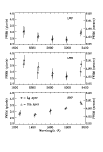The NEWSIPS spatial resolution has been determined by analyzing the
spectra of several low-dispersion standard stars (viz., HD 60753,
HD 93521, BD+33![]() 2642, and BD+75
2642, and BD+75![]() 325). The FWHM of large- and
small-aperture spectra were measured at several wavelengths and plotted
(see Figure 2.20). As is the case with the spectral resolution
studies, the NEWSIPS values show, in general, an improvement over
IUESIPS. As is the case with the spectral resolution plots, the
small-aperture data are slightly offset from the large-aperture data.
325). The FWHM of large- and
small-aperture spectra were measured at several wavelengths and plotted
(see Figure 2.20). As is the case with the spectral resolution
studies, the NEWSIPS values show, in general, an improvement over
IUESIPS. As is the case with the spectral resolution plots, the
small-aperture data are slightly offset from the large-aperture data.
LWP - The spatial resolution for the LWP is best near 3000Å where the FWHM for the large aperture is 2.4 pixels (3.6 arcsec), and decreases to values of around 3.0 pixels at the short- and long-wavelength ends of the spectrum. There is no significant difference between the large- and small-aperture spatial resolutions.
LWR - The behavior of the LWR camera as a function of wavelength is similar to the LWP, with the smallest FWHM values for the large aperture of 2.6 pixels (3.9 arcsec) occurring near 3000Å, and increasing to 3.6 and 3.0 pixels at the wavelength extremes. The small aperture, unlike the other two cameras, shows a dramatic decrease in resolution of approximately 10%.
SWP - The SWP camera shows the best spatial resolution near 1400Å with mean FWHM values for the large aperture of 2.7 pixels (4.1 arcsec), increasing slightly to 2.8 pixels at 1250Å, and 3.7 pixels at 1950Å. The SWP small-aperture resolution response is approximately the same as the large-aperture resolution.
 Figure 2.20: Low-dispersion spatial resolution.
Figure 2.20: Low-dispersion spatial resolution.